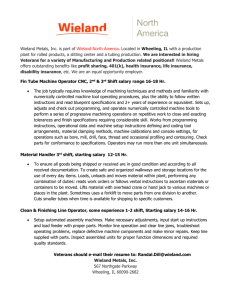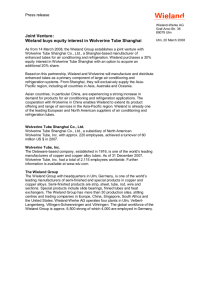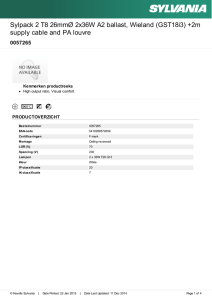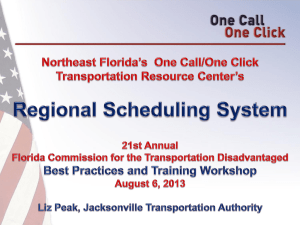Presentation 10
advertisement
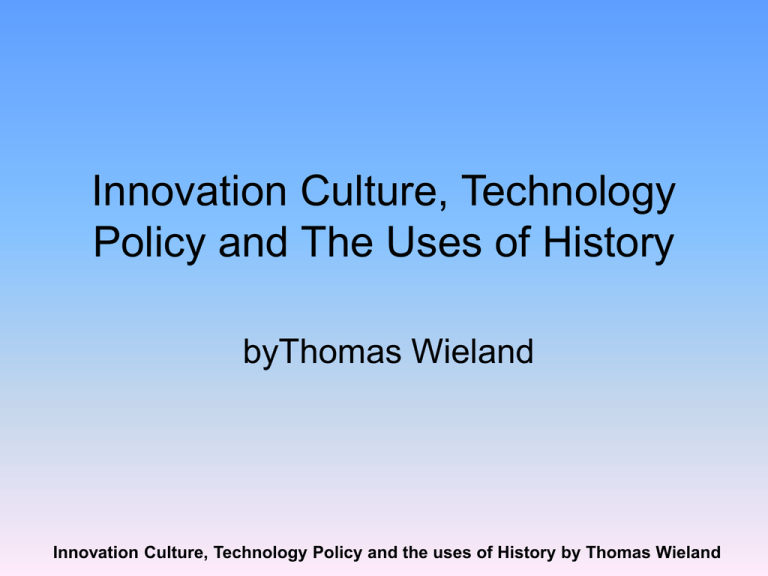
Innovation Culture, Technology Policy and The Uses of History byThomas Wieland Innovation Culture, Technology Policy and the uses of History by Thomas Wieland Innovation Systems & Culture • • • • Systems Organizational & institutional structures Directs rate and direction of innovation National, regional, sectoral Industrial R&D labs, Universities, Govt. agencies, patent systems • • • • • • Culture Technological vision Use of products Value systems of individuals and groups Research traditions Affects innovation systems Not recognized much, hence policies ineffective Innovation Culture, Technology Policy and the uses of History by Thomas Wieland Innovation Culture • Group’s or society’s framework that determines how things are viewed and how things are done by its individual members • Neither invariant nor universal • Produced and reproduced in social interactions by group or society members • Innovation Culture: Group’s or society’s framework that channels the perception of economic and technological challenges and provides strategies to meet them Innovation Culture, Technology Policy and the uses of History by Thomas Wieland Innovation Culture • Made of technological visions, values, research traditions of those who are part of innovation process • Reservoir of ideas • Provides proven strategies Innovation Culture, Technology Policy and the uses of History by Thomas Wieland Institutions • • • • Formal Consciously built with specific purpose and hence can be easily changed Actively participate in innovation Codified and explicit Patent laws, university curricula • • • • • • Informal Implicit, less visible Emerge spontaneously Internalized through socialization =culture Customs, traditions Affects the formal systems Innovation Culture, Technology Policy and the uses of History by Thomas Wieland Post WW II - Western Germany • Technology-taker in nuclear power plants, biotechnology, computers • Strengths in automobiles, machine tools,chemicals • Role of cultural factors for shaping technology policies • Computers & Biotechnology Innovation Culture, Technology Policy and the uses of History by Thomas Wieland Case Study - Computers • 1960s – IBM 70%, German players 10% • Siemens and AEG-Telefunken, two eletrotechnical firms asked for public funding • Govt. accepted as widening technological gap • Data Processing Programmes (DPP) launched in 1967, 1971, 1976 Innovation Culture, Technology Policy and the uses of History by Thomas Wieland Goals of DPPs • National computer industry to compete with US players • Use data processing to modernize industry and administration • Academic environment in computer science for training and cutting-edge research • 42% funds in industrial R&D, 29% data processing applications • Siemens and AEG benefited – national champions to develop mainframe computer Innovation Culture, Technology Policy and the uses of History by Thomas Wieland DPPs … • Research Ministry – data processing system 70/72 – military command, process control, weather control etc • Siemens, AEG refused to collaborate • Lot of money spent on mainframe as that was the vision • Transistors & ICs made smaller computers • Siemens & AEG both tried to compete with IBM Innovation Culture, Technology Policy and the uses of History by Thomas Wieland DPPs… • Siemens – JV with RCA – RCA withdrew • AEG – developed on own, but no business customers • 3rd DPP – focus on minicomputers Innovation Culture, Technology Policy and the uses of History by Thomas Wieland Disparity between goals & means • Goal of winning technology race in short term, means not commensurate • Siemens – elcetro-technical – power/transportation – $2.1Bn Vs $5.3 Bn of IBM • Technology development focus over marketing & user support Innovation Culture, Technology Policy and the uses of History by Thomas Wieland Culture • Symbols of scientific & technological superiority of USA • Self-esteem of Germany challenged as takers from makers • Glorious electro-technical industry – historical resource • “One must not undervalue the capacity of the German industry” • Decline in imagined hierarchy of nations • Competing with IBM – technological , hence marketing/support not developed • Business customers ignored for scientific/engineering purposes Innovation Culture, Technology Policy and the uses of History by Thomas Wieland Biotechnology • University Biology • Chemical Industry – ‘found’ • Pharmaceutical Industry - playground Innovation Culture, Technology Policy and the uses of History by Thomas Wieland Innovation Culture, Technology Policy and the uses of History by Thomas Wieland Thank You Innovation Culture, Technology Policy and the uses of History by Thomas Wieland
